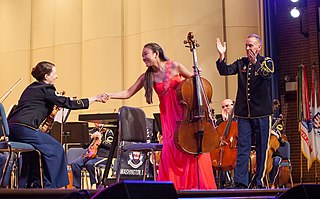
An orchestra is a large instrumental ensemble typical of classical music, which combines instruments from different families. There are typically four main sections of instruments:

Conducting is the art of directing a musical performance, such as an orchestral or choral concert. It has been defined as "the art of directing the simultaneous performance of several players or singers by the use of gesture." The primary duties of the conductor are to interpret the score in a way that reflects the specific indications in that score, set the tempo, ensure correct entries by ensemble members, and "shape" the phrasing where appropriate. Conductors communicate with their musicians primarily through hand gestures, usually with the aid of a baton, and may use other gestures or signals such as facial expression and eye contact. A conductor usually supplements their direction with verbal instructions to their musicians in rehearsal.

A concert is a live music performance in front of an audience. The performance may be carried by a single musician, sometimes then called a recital, or by a musical ensemble, such as an orchestra, choir, or band. Concerts are held in a wide variety and size of settings, from private houses and small nightclubs, dedicated concert halls, amphitheatres and parks, to large multipurpose buildings, such as arenas and stadiums. Indoor concerts held in the largest venues are sometimes called arena concerts or amphitheatre concerts. Informal names for a concert include show and gig.

A concert band, also called a wind band, wind ensemble, wind symphony, wind orchestra, symphonic band, the symphonic winds, or symphonic wind ensemble, is a performing ensemble consisting of members of the woodwind, brass, and percussion families of instruments, and occasionally including the harp, double bass, or bass guitar. On rare occasions, additional, non-traditional instruments may be added to such ensembles such as piano, synthesizer, or electric guitar.

The Sydney Symphony Orchestra (SSO) is an Australian symphony orchestra based in Sydney. Initially formed in 1908, the orchestra has performed at the Sydney Opera House as its home concert hall, since the venue's opening in 1973. Simone Young is the orchestra's chief conductor and the first female conductor in the post.

The concertmaster, first chair (U.S.) or leader (U.K.) is the principal first violin player in an orchestra. After the conductor, the concertmaster is the second-most significant leader in an orchestra, symphonic band or other musical ensemble.

A pit orchestra is a type of orchestra that accompanies performers in musicals, operas, ballets, and other shows involving music. The term was also used for orchestras accompanying silent movies when more than a piano was used. In performances of operas and ballets, the pit orchestra is typically similar in size to a symphony orchestra, though it may contain smaller string and brass sections, depending upon the piece. Such orchestras may vary in size from approximately 30 musicians to as many as 90–100 musicians. However, because of financial, spatial, and volume concerns, current musical theatre pit orchestras are considerably smaller.

A rehearsal is an activity in the performing arts that occurs as preparation for a performance in music, theatre, dance and related arts, such as opera, musical theatre and film production. It is undertaken as a form of practising, to ensure that all details of the subsequent performance are adequately prepared and coordinated. The term rehearsal typically refers to ensemble activities undertaken by a group of people. For example, when a musician is preparing a piano concerto in their music studio, this is called practising, but when they practice it with an orchestra, this is called a rehearsal. The music rehearsal takes place in a music rehearsal space.
The San Jose Youth Symphony (SJYS) is a non-profit youth orchestra located in San Jose, California.
The Pacific Symphony is a symphony orchestra based in Orange County, California. The orchestra performs at the Renée and Henry Segerstrom Concert Hall as a part of the Segerstrom Center for the Arts in Costa Mesa, California. From 1987 to 2016, the orchestra's Summer Festival concerts took place at the Irvine Meadows Amphitheatre in Irvine, California.
Marc Engelhardt is a German bassoonist.
The Mahler Chamber Orchestra is a professional touring chamber orchestra founded by Claudio Abbado and former members of the Gustav Mahler Youth Orchestra in 1997.

A music stand is a pedestal or elevated rack designed to hold sheets of music in position for reading. Most music stands for orchestral, chamber music or solo orchestra-family instruments can be raised or lowered to accommodate seated or standing performers, or performers of different heights. Many types of keyboard instruments have a built-in or removable music rack or stand where sheet music can be placed. Music stands enable musicians to read sheet music or scores while playing an instrument or conducting, as the stand leaves the hands free. For choirs, singers typically hold their music in a folder, and singers performing solo recitals or opera performances typically memorize the lyrics and melodies. Some singers use stands, such as lounge singers and wedding vocalists who have a repertoire of hundreds of songs, which makes remembering all of the verses difficult.

The European Union Youth Orchestra (EUYO) is a youth orchestra with members drawn from the 27 members states of the European Union. Since its foundation in 1976, it has connected music colleges and the professional music world for generations of European musicians. EUYO is considered one of the best youth orchestras in the world, achieving "extraordinarily high standards" and playing at all major European festivals, including the Proms, the Salzburg Festival, and Young Euro Classic.
Founded in 1976, the Elgin Youth Symphony Orchestras (EYSO) is the oldest and largest youth orchestra program in northwest Illinois and is composed of three full orchestras, two string orchestras, a brass choir, two percussion ensembles, a flute choir, and a large Chamber Music Institute.
Ensemble librarianship is an area of music librarianship which specializes in serving the needs of musical ensembles, including symphony and chamber orchestras, opera houses, ballet companies, wind ensembles and educational institutions. Ensemble librarians acquire printed music and prepare it for performance.

Derek Gleeson is an Irish/American musician. Born in Dublin, Ireland. He is currently the music director and conductor of the Dublin Philharmonic Orchestra and has been the conductor at the Anna Livia Dublin International Opera Festival. Since 2012 Gleeson is also music director & conductor of the Rachmaninov Festival Orchestra. Since January 2016 Gleeson is Principal Guest Conductor or The Harbin Symphony Orchestra, Harbin, China. He also composes musical scores for film and television and of symphonic music for the concert hall.

The National Youth Orchestra of the United States of America (NYO-USA) is the national youth orchestra of the United States. Organized by Carnegie Hall's Weill Music Institute, it was established in 2012, and its first concert tour took place in the summer of 2013. Each summer, following an application and audition process, about 110 musicians ages 16 to 19 attend a two-week residency at Purchase College, New York, followed by a national or international tour.

The National Youth Orchestra of China is a full symphony youth orchestra composed of approximately 100 Chinese musicians aged 14 to 21 years old. Students from all over China audition to participate in a two-week training residency before performing alongside a renowned soloist and conductor in premier venues throughout the world.

Sir Ian Isaac Stoutzker CBE was a British banker, musician and philanthropist.















